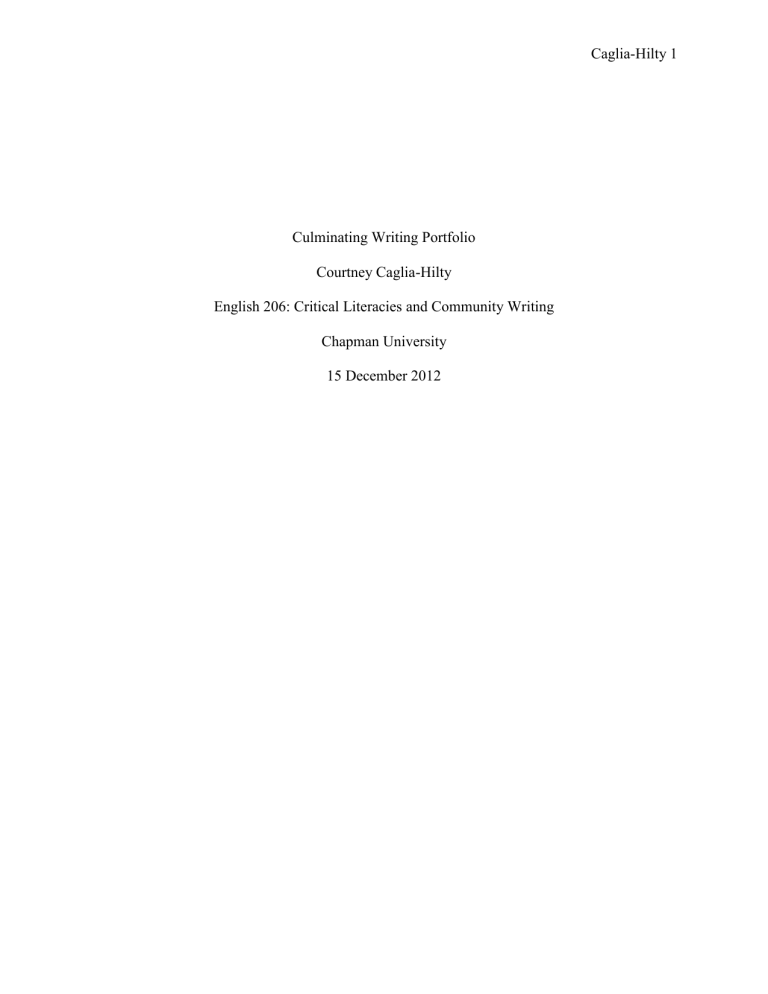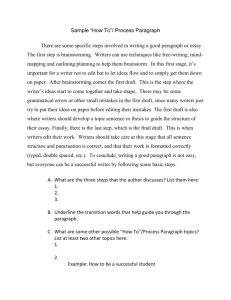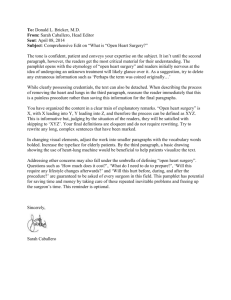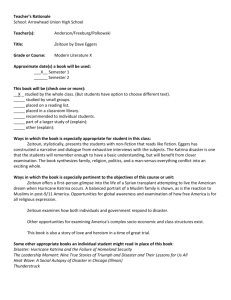Caglia-Hilty 1 Culminating Writing Portfolio Courtney Caglia
advertisement

Caglia-Hilty 1 Culminating Writing Portfolio Courtney Caglia-Hilty English 206: Critical Literacies and Community Writing Chapman University 15 December 2012 Caglia-Hilty 2 Table of Contents Introduction …………………………………………………………………………. page 3 Writers Read ………………………………………………………………………… pages 3-6 Writers Write ………………………………………………………………………... page 6-11 Writers Demonstrate Achievement …………………………………………………. Page 11-12 Works Cited …………………………………………………………………………. page 12 Caglia-Hilty 3 Throughout the Fall 2012 semester of English 206: Critical Literacies and Community Writing, I was assigned with readings, and journal entry and writing assignments to further my understanding of writing and the process of writing. Through the dissection of works by Adam Gopnik, David Foster Wallace, Dave Eggers, and other noted authors and poets, as well as the critique of my own works, I have come to understand the concepts of critical literacies and community writing. This assignment is a culmination of that critique of others’ and my own works. Being aware and critical of the rhetorical choices and stylistic differences in writings can help to further one’s own writing abilities. My own writing has greatly benefited from working to understand writing choices, why those choices are made, and how those choices affect the writing and meaning of the entire piece. As a developing writer, I am finding my own writing voice as I discover and further understand others’ writing voices and what makes them so unique. My own individual way of writing is identifiable through the rhetorical and stylistic choices I make. Writings designed for a public forum have been written in a specific manner with specific intentions. The author takes care to write in such a way that will adapt to the community for which he or she is writing. Writers Read After reading “Bumping into Mr. Ravioli” by Adam Gopnik, I thought about the language in my writing and ensuring that language does work and is not just filling space. Using intentional language that prompts readers to think about not only the content of a piece, but the style of the piece is effective in making the connection between concepts. Gopnik’s use of “bumping into” as opposed to “passing by” or “seeing” makes the piece real. People can relate to the idiom as something they say on a daily basis. Gopnik’s overuse and analysis of such Caglia-Hilty 4 phrases as “bumping into,” “grabbing lunch,” and “hopping into a taxi” (80) effectively elicits a response of agreement and personal relation from readers. Further, the choice of using “business” and “busyness” (81) in the same sentence causes readers to take a second look, and therefore reread and rethink the difference between the two words. Returning to the concept of busyness later in the article and declaring it an art form in the current life of New Yorkers once again forces readers to pause and contemplate the idea, making a decision as to whether or not they agree (84). I found David Foster Wallace’s two-sided argument to “Consider the Lobster” simultaneously interesting and boring. The subject of lobster as an argument is immediately offputting and seemingly unimportant. Upon reading the article, however, I discovered the set-up of the paper compelling. The use of ethos, logos, and pathos to create a well-rounded argument that appealed to the thought processes of any type of thinker. In my own writing I am strong in the ethos and pathos types of writing, but I struggle with logos. I tend to write with heart and emotion as the support for my ideas, and leave out, or use very little of, the scientific or proven facts that would be great references to attach to any writing. Just the citation of the encyclopedia to define and clarify and questions a reader may have heightens the scientific relevance of the paper already (286). Additionally using the works of writers who have worked with the same issues or content to provide evidence for an idea only encourages the reader to continue reading because it adds to the merit of the paper. Wallace does this when he cites the main criteria “for determining whether a living creature has the capacity to suffer” (295). Having a balance of the three different appeals is key to reaching a wider audience. Eggers’s strategic placement of different flashbacks to create a personal and emotional connection with the Zeitouns as well as an avenue for introduction to a larger problem is Caglia-Hilty 5 something that I would love to bring to life in my own writing. Maybe not flashbacks necessarily, but bringing something completely separate from the story or idea that is the focus of the work, seeing a connection, and using that connection to create a broader vision, is something that would help readers to make meaning of the focal point. Kathy’s flashback to the unending walk to reach the top of the rock while on vacation is a perfect example of an outside connection (196-200). The story encapsulates Zeitoun’s stubborn nature which is the reason he stayed in New Orleans to whether the storm. Zeitoun’s sense that there is something greater than himself pushing him to do the things he does—touch the rock, stay during Katrina, feed the dogs, rescue people throughout the city—is made clear with this story. Rather than simply stating something, using an outside connection is helpful in setting the stage for further growth of an idea. With respect to “Telescope” by Louise Gluck, pace was the most prominent piece of the poem that I saw. When reciting the piece, the poem seemed to elicit different emotions and meaning dependent on the speed and inflection with which the words were given. The last two stanzas were especially altered with different paces of recitation. It seems to have more meaning as you build up and space the lines more and more as the final line approaches. You realize afterward not that the image is false but the relation is false. You see again how far away each thing is from every other thing. (14-18) When reading the first line of the second-to-last stanza more slowly, it truly seems like an afterthought that the relation is false. Reading the last stanza even more slowly allows for the realization that the universe is so incredibly vast, as if while going over the lines, the reader is discovering just how large and how far the distance expands from one thing to the next in this Caglia-Hilty 6 life. The pacing aspect of writing in poetry is important, but not so startling. In prose, however, I find that I often overlook the idea of pacing. I now realize that I am able to pace a work based on the content and the language within it. Another poetry-to-prose idea translation which was brought to my attention in this class was the break of conventional structure. Jaime Dedes’s “Other Mothers’ Children” proved more difficult to memorize because of the break of “normal” styling. As opposed to “Telescope,” where almost every line pauses at the end of it, “Other Mothers’ Children” is almost a continuous run-on sentence with pauses in the middle of lines. A line that was particularly difficult to remember in terms of continuity was “Other mothers’ children stare unseeing / From shattered hovels, no sweet, wet/ Baby kisses from blistered lips with songs unsung” (3-5). My peers and I always seemed to want to pause after “unseeing” (3). This startling difference in style made me stop and think about the words themselves and what they mean. Changing the normal style of one’s writing has the same effect in prose as well. Sometimes a single sentence as a paragraph has more of an affect than of a block paragraph that relays the same ideas. This is something I have to constantly remind myself. I am hoping that with time and effectively using different styles, I will become more comfortable and confident in deviating from the normal and accepted academic style of writing. Writers Write Chronologically, the first assignment completed in this course which is included in this portfolio is the transcription from the foreword of The Elements of Style by William Strunk, Jr. and E.B. White. I feel like the choice of this particular sentence is highly indicative of how I felt about my own writing, and still feel about it, to a point. At the beginning of the course as this was transcribed on September 4th, I felt lost when it came to writing. I never felt, and still do not feel Caglia-Hilty 7 as if my writing is “right.” Instead it looks wrong as I read and reread it. I am wordy, or using the wrong words, or going about conveying my ideas in the wrong ways. I am “What should be easy and flowing looks tangled or feeble or overblown—not what was meant at all. What’s wrong with me one thinks. Why can’t I get this right?” (Strunk & White vii) always questioning my writing, which is good, and should lead to positive criticism and better writing. Sometimes I worry too much about how others will perceive my writing, which leads to over analysis about how I should be writing. I get tangled up in not only my writing, but my own thoughts as well. This course and the work assigned have given me the tools and tiny push necessary to stray away from my thoughts and just write. Instead of focusing on the tangled, I am able to view and critique why my writing seems tangled and decide whether or not it is tangled for a purpose. In sketching and explaining one of Kalman’s sketches from Elements of Style, I was able to play with multi-modal works. Integrating my sketch of the Illusion sketch was new and, I believe, opened a door to varied writing structure and word play. I enjoyed the interaction of “allusion” and “illusion” throughout the paper and sketch to convey the basic difference between the two words. I chose this pair of words in particular because Kalman’s associated sketch was so intriguing. There were a number of ways in which the sketch could be explained, but I believe the “box creating an illusion” and colors alluding “to the idea that there is more than what meets the eye” is accessible to any reader. In the Gopnik Model Write, I continued the play with words referenced above, and tried to work even more to use words to my advantage as a writer because that was something I Caglia-Hilty 8 noticed Gopnik do so well. I started my paper with “My residents, still new to college life, still new to being on their own, are still not familiar with who lives just down the hall from them.” The impact of the repetitious “still” increases after each use. It creates a draw for readers to continue reading. Further along in my would-be article, I place responsibility on the readers to further their interest by inserting “we” throughout. “We are, in general, more socially inept” and “We hide behind our computers or smart phones all day” may put readers on guard, but I think an ownership of a problem creates a bigger interest in the problem. I used “we” instead of “you” to also bring ownership to myself, so as not to accuse others; instead, it is being stated somewhat matter-of-factly. For my “twig” product I wrote a poem titled “Time.” Time was what I thought of immediately when deciding upon a concept with which to connect the “twig.” Reason being, in the short amount of time I had the twig up to that point, it had changed so much. Time is so precious. The twig’s leaves were originally a gorgeous, deep green and they were now spotted, splotchy, and faded with age—like “an elderly old gentleman.” I use anaphora and repetition quite a bit throughout the piece because I feel like repetition is representative of time, what with the repetitious sounds of clocks and the popular saying that “history always repeats itself.” The ethical dilemma paper definitely posed a dilemma for me. I struggled with even coming up with a dilemma I felt a strong desire to write about. When I heard a derogatory slur within my own Residence Hall, however, I was amped up enough to write about speaking out against such slurs. Once I started writing, I decided to really push my readers’ thinking about the topic by placing them into a number of very specific, very different situations to exemplify one type of discrimination. From this, I would hope they could make a decision, or at least think about how a decision could be made, as to whether or not they should speak out against such Caglia-Hilty 9 derogatory and hateful speech. Instead of just writing about the subject of discrimination and whether or not it is a “bad” thing, potential real life scenarios are more effective in prompting critical thought. Unfortunately, my Memory Now paper was one of those papers where I retracted to the questioning writer of writing classes past and did nothing original. The paper was definitely subpar, not offering anything new or groundbreaking by way of language, structure, or style in the writings of Courtney. The most exciting and alluring thing about the paper was the descriptive language, which should go without saying. I am not usually a fan of having to illustrate or sketch anything, as I am not very artistic. The Zeitoun illustrations, however, were something I could bear. On November 5th, I actually particularly enjoyed sketching this scene. The description of the many soldiers with giant guns standing strongly against one lone man in a canoe looking for a team to rescue his neighbor was just too vivid not to draw. The quote that I wrote with the illustration also stuck me as just so blunt and so telling of the regression of a society in turmoil following a natural disaster. It was not the government’s “problem” to rescue those who needed rescuing. Instead, it was this one man’s. It was now his responsibility to save the lives of his fellow New Orleanians. Instead this militia would just stand there menancingly with their guns. I left the soldiers without faces because they were all the same. No one person stepped up to help. It was as if all of them came out of a machine of carelessness. Caglia-Hilty 10 My Sense of Destiny paper was a paper that included many questions directed at myself, but the big change in this particular paper, though sizably very small, was my last paragraph. “I am to serve and help others.” Such a short, bold sentence made a world of difference. Prior to in-class draft readings, it was attached to the paragraph before. With the suggestions and urging of my classmates, I decided to take the chance and make the sentence it’s own paragraph. It may sound small, but it is a big step for me with regard to my writing structure abilities. I have always been told that a sentence does not constitute a paragraph. Throughout my schooling, a paragraph has been structured as some version of “at least five sentences, with a topic sentence, supporting points, etc.” Every time I read an article, book, or other piece with a powerful sentence as a paragraph by itself, I always think to myself how bold that writer is and how great and commanding the paragraph is. I took the leap and did it in this paper. “I am to serve and help others” is the culminating sense of destiny and is just succinct enough to get the point across that helping and serving is my destiny. For the final Zeitoun paper, I pulled from Eggers writing style in that I took an outside connection to help create a sense of a larger idea. The turn of events in the personal lives of the Zeitoun family following the publishing of Zeitoun was related to the content of the novel. I used to to introduce and expand the idea of corruption—governmentally and personally—in the lives of those affected by disasters. Additionally, I included a photograph of a prisoner in a New Orleans prison to make the impact of being in prison more tangible for readers. Sometimes images help to make a concept more real and more understandable. I felt that his was one of those cases. I also increased the variance in my sentence structure throughout. The conclusion paragraph exemplifes this variance: “For me, the name Zeitoun will forever be synonymous with a fallen hero. A good man turned bad. A peace-maker turned peace-breaker. A gentle man Caglia-Hilty 11 turned violent. A free man turned prisoner. An innocent turned corrupt.” The choppiness of the sentences creates a sense of finality and closing. I feel like this paper best shows how far I have come, even over just the course of one semester. At the beginning of the semester I would not have implemented any of these tools or styles into my writing. Writers Demonstrate Achievement Review and Revision: The sound of the clock ticking; students wait to hear the bell ring. The sight of the numbers changing on the phone; a lonely woman can’t fall asleep. A small boy slowly developing into a man then into an elderly old gentleman. A tree shedding its leaves. This first stanza of my poem, “Time,” the “twig” project, has been edited to make sure that all words are essential. Because poetry is language which has been condensed, all words must do work and be vital to the meaning of the poem. I established a place in the line “students wait to hear the bell ring” as opposed to “as seconds go by” which did little for the poem. I also created a second stanza instead of keeping it all as one stanza. Style: I feel a moral imperative to stand up to the hurtful man and tell him that what he’s saying is not okay and that this couple is simply two human beings who care for one another just as he and his assumed wife or girlfriend do. While I think I should act upon my instinct to help others, in reality if this happened, I might take a moment to think about whether it’s actually a good idea to step in… You’re expecting the punchline to be offensive and probably racist. Do you stop him before he finishes the joke? No. You give him the benefit of the doubt, even though you don’t see how it couldn’t go there. Here it comes: “Your homework is done and your computer is upgraded, but two hours later, he’s still trying to back out of your driveway.” Now you should really say something, right?” Caglia-Hilty 12 I feel like my style is very emotional and personal. I try to identify realistic or real life situations and scenarios with which to relate a larger ideal in order to increase the comprehension of said idea. I ask many questions which can be translated to internal questioning and struggle. My writing voice has evolved this semester to be identifiable as more friendly than academic. Idea: We are interconnected, in contact, and within such close proximity with the same people all the time, but we don’t attempt to make any true connection with them… We substitute Facebook-to-Facebook interaction for meaningful, and in my personal opinion, more genuine, face-to-face interaction. That’s just the way it is though. I don’t think there’s any going back…It all starts with a connection—a smile, a wave, a short conversation. I feel like the language in this work communicates the idea in such a way that is matterof-fact while still prompting critical analysis and thinking to come up with a potential solution. The last two sentences come across as a challenge of sorts. For a reader to be challenged though, he must understand the communicated idea first. This work does that. Works Cited Dedes, Jaime. “Other Mothers’ Children.” Web. 30 August 2012. <http://poemalone.wordpress.com/tag/children/>. Eggers, Dave. Zeitoun. New York: Vintage Books, 2009. Print. Gluck, Louise. “Telescope.” The New Yorker 17 January 2005: 52. Print. Gopnik, Adam. “Bumping into Mr. Ravioli.” The New Yorker 30 September 2002: 80-84. Print. Strunk, William Jr. and E. B. White. The Elements of Style. Illus. Maira Kalman. New York: Penguin Books, 200. Print. Wallace, David Foster. Consider the Lobster and Other Essays. Little, Brown and Co., 2005. 284-300. Print.







